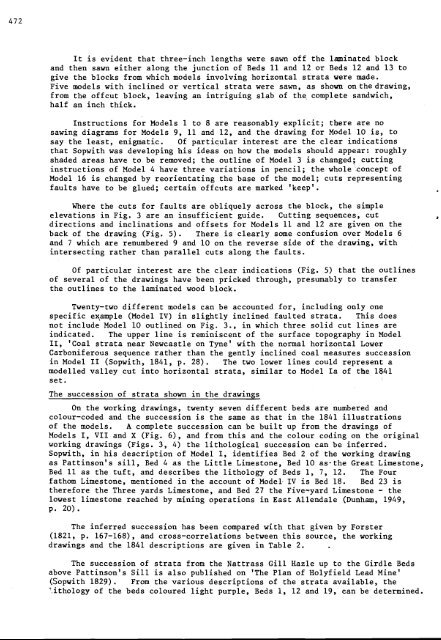E;*+ - Geological Curators
E;*+ - Geological Curators
E;*+ - Geological Curators
You also want an ePaper? Increase the reach of your titles
YUMPU automatically turns print PDFs into web optimized ePapers that Google loves.
It is evident that three-inch lengths were sawn off the laminated block<br />
and then sawn either along the junction of Beds 11 and 12 or Beds 12 and 13 to<br />
give the blocks from which models involving horizontal strata were made.<br />
Five models with inclined or vertical strata were sawn, as shown onthedrawing,<br />
from the offcut block, leaving an intriguing s1,ab of the, complete sandwich,<br />
half an inch thick.<br />
Instructions for Models 1 to 8 are reasonably explicit; there are no<br />
sawing diagrams for Models 9, 11 and 12, and the drawing for Model 10 is, to<br />
say the least, enigmatic. Of particular interest are the clear indications<br />
that Sopwith was developing his ideas on how the models should appear: roughly<br />
shaded areas have to be removed; the outline of Model 3 is changed; cutting<br />
instructions of Model 4 have three variations in pencil; the whole concept of<br />
Model 16 is changed by reorientating the base of the model; cuts representing<br />
faults have to be glued; certain offcuts are marked 'keep'.<br />
Where the cuts for faults are obliquely across the block, the simple<br />
elevations in Fig. 3 are an insufficient guide. Cutting sequences, cut<br />
directions and inclinations and offsets for Models 11 and 12 are given on the<br />
back of the drawing (Fig. 5). There is clearly some confusion over Models 6<br />
and 7 which are renumbered 9 and 10 on the reverse side of the drawing, with<br />
intersecting rather than parallel cuts along the faults.<br />
Of particular interest are the clear indications (Fig. 5) that the outlines<br />
of several of the drawings have been pricked through, presumably to transfer<br />
the outlines to the laminated wood block.<br />
Twenty-two different models can be accounted for, including only one<br />
specific ex-ample (Model IV) in slightly inclined faulted strata. This does<br />
not include Model 10 outlined on Fig. 3., in which three solid cut lines are<br />
indicated. The upper line is reminiscent of the surface topography in Model<br />
11, 'Coal Strata near Newcastle on Tyne' with the normal horizontal Lower<br />
Carboniferous sequence rather than the gently inclined coal measures succession<br />
in Model I1 (Sopwith, 1841, p. 28). The two lower lines could represent a<br />
modelled valley cut into horizontal strata, similar to Model Ia of the 1841<br />
set.<br />
The succession of strata shown in the drawings<br />
On the working drawings, twenty seven different beds are numbered and<br />
colour-coded and the succession is the same as that in the 1841 illustrations<br />
of the models. A complete succession can be built up from the drawings of<br />
Models I, V11 and X (Fig. 6), and from this and the colour coding on the original<br />
working drawings (Figs. 3, 4) the lithological succession can be inferred.<br />
Sopwith, in his description of Model I, identifies Bed 2 of the warking drawing<br />
as Pattinson's sill, Bed 4 as the Little Limestone, Bed 10 as-the Great Limestone,<br />
Bed 11 as the tuft, and describes the lithology of Beds 1, 7, 12. The Four<br />
fathom Limestone, mentioned in the account of Model, IV is Bed 18. Bed 23 is<br />
therefore the Three yards Limestone, and Bed 27 the Five-yard Limestone - the<br />
lowest limestone reached by mining operations in East Allendale (Dunham, 1949,<br />
p. 20) .<br />
The inferred succession has been compared with that given by Forster<br />
(1821, p. 167-168), and cross-correlations between this source, the working<br />
drawings and the 1841 descriptions are given in Table 2.<br />
The succession of strata from the Nattrass Gill Hazle up to the Girdle Beds<br />
above Pattinson's Sill is also published on 'The Plan of Holyfield Lead Mine'<br />
(Sopwith 1829). From the various descriptions of the strata available, the<br />
'ithology of the beds coloured light purple, Beds 1, 12 and 19, ean be determined.

















